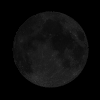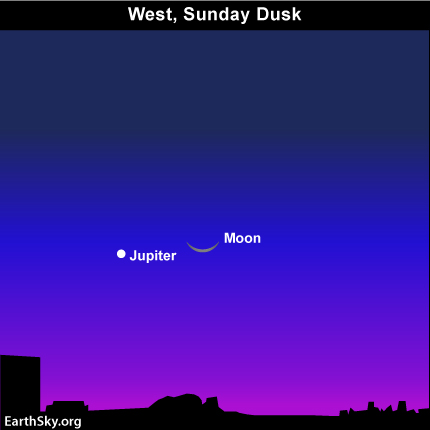Courtesy of EarthSky
A Clear Voice for Science
Visit EarthSky at
www.EarthSky.org

 As seen from North America on March 6, the waxing crescent moon and dazzling planet Jupiter shine nearly side by side in the western sky after sunset.
As seen from North America on March 6, the waxing crescent moon and dazzling planet Jupiter shine nearly side by side in the western sky after sunset.
Given clear skies, virtually everyone in the northern hemisphere will see the two brightest celestial bodies of the March evening sky – the moon and Jupiter – at dusk and nightfall tonight. In Europe, Africa, and Asia, people will see Jupiter to the upper left of the moon – instead of to the side of the moon – but they will see the glorious evening couple all the same.
Meanwhile, folks at middle latitudes in the southern hemisphere – for example, South Africa, Australia, and New Zealand – probably won’t see the moon at all after sunset this Sunday evening. In fact, this part of the world might not even see much of Jupiter, because Jupiter follows the sun beneath the horizon about an hour after sunset at mid-southern latitudes. Here at mid-northern latitudes, Jupiter sets about 2 hours after the sun.
So why are the moon and Jupiter more visible in the northern hemisphere? It is because late winter now reigns in the northern hemisphere and late summer in the southern hemisphere. On late winter and early spring evenings, the ecliptic – the pathway of the sun, moon, and planets – hits the horizon at the steepest angle for the year. However, on late summer and early autumn evenings, the ecliptic hits the horizon at its shallowest angle.
Looking for a sky almanac? EarthSky recommends . . .
Late winter/early spring evenings also present the best time to see earthshine on the nighttime side of the waxing crescent moon. Enjoy the wondrous moon-and-Jupiter attraction after sunset on the evening of March 6, and note the smiling moon – a sure sign of winter giving way to spring!
When can you see earthshine on a crescent moon?
Astronomy Picture of the Day from NASA/JPL
U.S. Naval Observator Astronomical Information center
The York County Astronomical Society